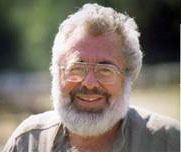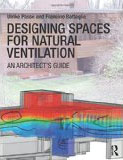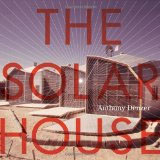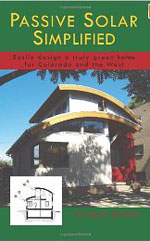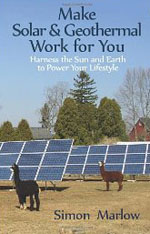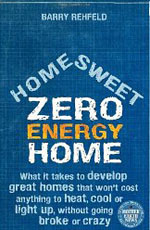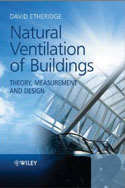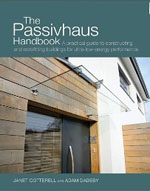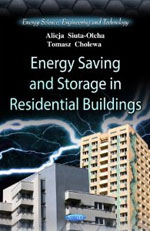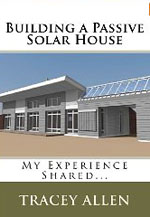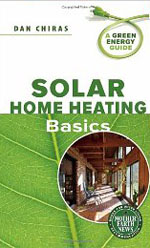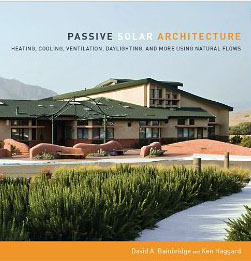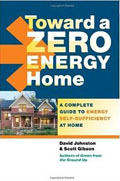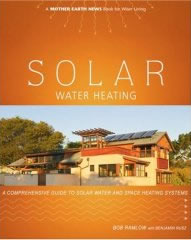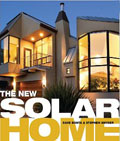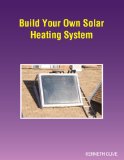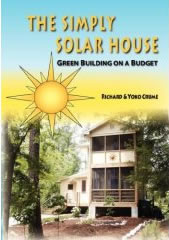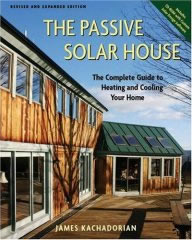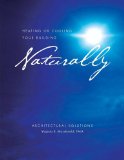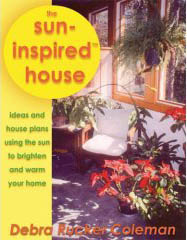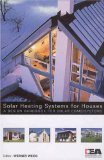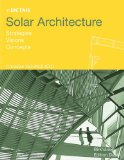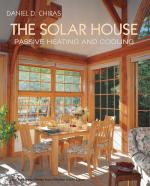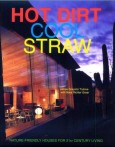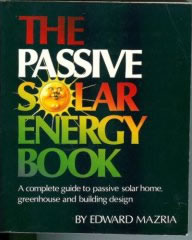Heat with the Sun
and Passive Cooling
Nothing can be more comfortable for body and mind than living in a good solar-heated house. I say "good", because proper design is crucial to the comfort of such a house. You may have gone into a solar house and felt stifled by the glaring heat, or perhaps you shivered from the lack of it. Good passive solar design will provide just enough sunlight into the rooms to be absorbed by the surrounding thermal mass (usually masonry materials), so that the heat will be given back into the room when the sun goes down. The thermal mass is a kind of "heat battery" that stores the warmth, absorbing it to keep the room from getting too hot during the day. Equally important to thermal mass is insulation (such as straw bales, crushed volcanic rock, or thermal shades) that will keep that heat inside. Thermal mass materials need to be insulated from the outside, or else they will just bleed that warmth right back out. A rock house might have tons of mass, but be uncomfortably cold because of this energy bleed. So a good solar design will utilize materials of the right type in the right places, blending thermal dynamics with utilitarian design.
Many of the same principles that work to heat living space will also serve to keep that place cool in hotter weather. Other passive cooling strategies include wind towers that catch breezes and direct them through a house, and simple evaporative cooling concepts.
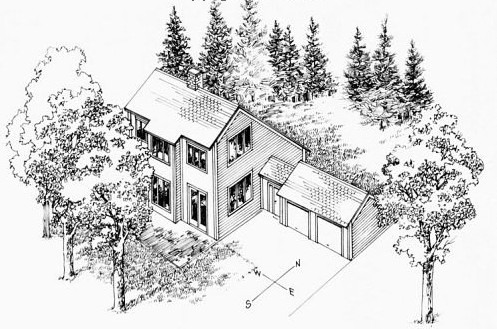
The books shown below are arranged according to when they were published, with the most recent ones at the top. If you click on one of the images you will be taken to a page at Amazon.com where you can find out more about the book. If you end up buying one of them, greenhomebuilding.com will receive a small commission that will help cover the cost of maintaining this website. Thanks for your patronage.
Plans
Chez Soleil
Paul Breaux, Designer
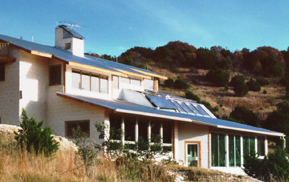 This is a 3 bedroom, 2 story, 3000 sf house, with attached garage. The design goals were to build a resource efficient, off-the-grid solar home, with no connected public utilities other than a phone line, and to use the home to generate performance data that would document how well the home's design and materials performed to keep the house cool in summer and warm in winter. According to Paul Breaux, a physicist, Chez Soleil performs much better than he expected. The home's temperature is comfortable year round, there is little home maintenance and operating expense, and the many people who tour the home can see and feel the benefits of "green" construction.Very little artificial lighting is needed during the day; natural light is plentiful on both the first and second floors due to window placement and open floor design. Chez Soleil has been written up in several publications including Environmental Design & Construction, the Austin American-Statesman, Southern Living, Mother Earth News, and Solar Today. Chez Soleil was selected by the American Solar Energy Society for the society's solar home tours, and was featured at the 23rd National Passive Solar Conference.
This is a 3 bedroom, 2 story, 3000 sf house, with attached garage. The design goals were to build a resource efficient, off-the-grid solar home, with no connected public utilities other than a phone line, and to use the home to generate performance data that would document how well the home's design and materials performed to keep the house cool in summer and warm in winter. According to Paul Breaux, a physicist, Chez Soleil performs much better than he expected. The home's temperature is comfortable year round, there is little home maintenance and operating expense, and the many people who tour the home can see and feel the benefits of "green" construction.Very little artificial lighting is needed during the day; natural light is plentiful on both the first and second floors due to window placement and open floor design. Chez Soleil has been written up in several publications including Environmental Design & Construction, the Austin American-Statesman, Southern Living, Mother Earth News, and Solar Today. Chez Soleil was selected by the American Solar Energy Society for the society's solar home tours, and was featured at the 23rd National Passive Solar Conference.
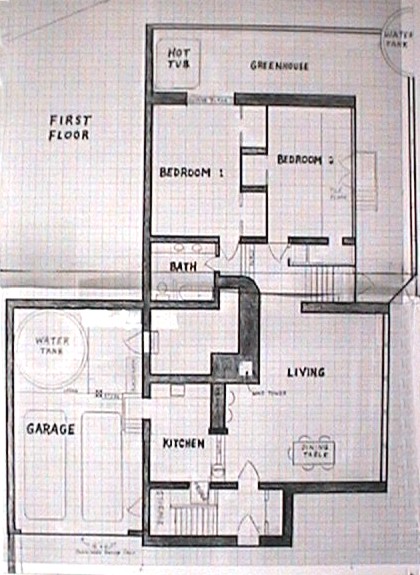 The house was primarily designed for southern exposure to maximize passive solar gain and the efficiency of rooftop solar collectors for electricity. The dining room, living room, and kitchen are incorporated into one open space to give as much utility as possible, and help the home maintain a comfortable and even internal temperature year around. An “attached sunspace” on the east and part of the south sides of the house is an integral part of what makes the house work so well. It provides solar heating during winter, and 700 square feet of growing room. It is a “buffer zone” during warm weather, as large overhangs shade the direct sun out.
The house was primarily designed for southern exposure to maximize passive solar gain and the efficiency of rooftop solar collectors for electricity. The dining room, living room, and kitchen are incorporated into one open space to give as much utility as possible, and help the home maintain a comfortable and even internal temperature year around. An “attached sunspace” on the east and part of the south sides of the house is an integral part of what makes the house work so well. It provides solar heating during winter, and 700 square feet of growing room. It is a “buffer zone” during warm weather, as large overhangs shade the direct sun out.
The lower part of the foundation is not insulated; it is coupled to the warmer subsoil, which stays at about 70 degrees all year. This system allows the home's thick thermal mass walls to dissipate heat during the summer, and absorb and retain heat when it is cool. The system helps maintain a relatively consistent indoor year around temperature without the need to use a nonrenewable energy source. The main concern was to balance heat gain during the winter with heat dissipation during the summer. Subsoil temperature fluctuations on this particular site were determined, and used to determine how deep the foundation's insulation should go on each side of the house.
Stored solar heat is released from the water containers as needed. Heat flows naturally by low temperature radiation and by warm air convection to the north side of the house, thus balancing comfort zones throughout the living space.
For more information about this plan, and many others, visit our sister site www.dreamgreenhomes.com, where you will find a wide range of plans for sustainable homes, greenhouses, small buildings, garages, and food storage space for sale. Dream Green Homes is a consortium of outstanding architects and designers, who have pooled their talent and expertise for your benefit.
Informative Links
General
consumerenergycenter.com good overview of passive solar concepts.
susdesign.com has some wonderful online tools for calculating proper window overhang design and heat gain for passive solar.
thebrecklife.com explains what is called "The Passive House Standard" and thezebra.com has an infogrphic about it.
Passive Annula Heat Storage
norishouse.com describes how a PAHS house can keep an underground house comfortable year round with no additional heat source.
Solar Hot Air
mobilehomerepair.com describes how to make a simple and inexpensive solar air heater.
Geothermal
Seabird Island Project shows unique design for the solar heating of water and space through warm air collection and geothermal heat tubes.
Shades
Instructions for how to make your own Roman Sailshade without the need to sew the fabric.

For Email contact go to About Us
Established in 2001, GreenHomeBuilding.com is primarily a labor of love. Kelly, and the GreenHomeBuilding team of experts, have answered thousands of questions for readers over the years, and we continue to publish up-to-date information about increasingly important sustainable architecture. If you feel moved to assist us in this work, your kind donation would be much appreciated; this can be easily done through our PayPal account:

VISIT OUR OTHER WEBSITES:
[Natural Building Blog] [Earthbag Building] [Dream Green Homes]
Disclaimer Of Liability And Warranty
I specifically disclaim any warranty, either expressed or implied, concerning the information on these pages. Neither I nor any of the advisor/consultants associated with this site will have liability for loss, damage, or injury, resulting from the use of any information found on this, or any other page at this site. Kelly Hart, Hartworks LLC.


